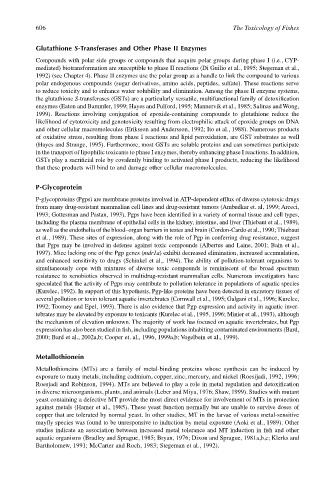Page 626 - The Toxicology of Fishes
P. 626
606 The Toxicology of Fishes
Glutathione S-Transferases and Other Phase II Enzymes
Compounds with polar side groups or compounds that acquire polar groups during phase I (i.e., CYP-
mediated) biotransformation are susceptible to phase II reactions (Di Guilio et al., 1995; Stegeman et al.,
1992) (see Chapter 4). Phase II enzymes use the polar group as a handle to link the compound to various
polar endogenous compounds (sugar derivatives, amino acids, peptides, sulfate). These reactions serve
to reduce toxicity and to enhance water solubility and elimination. Among the phase II enzyme systems,
the glutathione S-transferases (GSTs) are a particularly versatile, multifunctional family of detoxification
enzymes (Eaton and Bammler, 1999; Hayes and Pulford, 1995; Mannervik et al., 1985; Salinas and Wong,
1999). Reactions involving conjugation of epoxide-containing compounds to glutathione reduce the
likelihood of cytotoxicity and genotoxicity resulting from electrophilic attack of epoxide groups on DNA
and other cellular macromolecules (Eriksson and Andersson, 1992; Ito et al., 1988). Numerous products
of oxidative stress, resulting from phase I reactions and lipid peroxidation, are GST substrates as well
(Hayes and Strange, 1995). Furthermore, most GSTs are soluble proteins and can sometimes participate
in the transport of lipophilic toxicants to phase I enzymes, thereby enhancing phase I reactions. In addition,
GSTs play a sacrificial role by covalently binding to activated phase I products, reducing the likelihood
that these products will bind to and damage other cellular macromolecules.
P-Glycoprotein
P-glycoproteins (Pgps) are membrane proteins involved in ATP-dependent efflux of diverse cytotoxic drugs
from many drug-resistant mammalian cell lines and drug-resistant tumors (Ambudkar et. al, 1999; Arceci,
1993; Gottesman and Pastan, 1993). Pgps have been identified in a variety of normal tissue and cell types,
including the plasma membrane of epithelial cells in the kidney, intestine, and liver (Thiebaut et al., 1989),
as well as the endothelia of the blood–organ barriers in testes and brain (Cordon-Cardo et al., 1990; Thiebaut
et al., 1989). These sites of expression, along with the role of Pgp in conferring drug resistance, suggest
that Pgps may be involved in defense against toxic compounds (Albertus and Laine, 2001; Bain et al.,
1997). Mice lacking one of the Pgp genes (mdr1a) exhibit decreased elimination, increased accumulation,
and enhanced sensitivity to drugs (Schinkel et al., 1994). The ability of pollution-tolerant organisms to
simultaneously cope with mixtures of diverse toxic compounds is reminiscent of the broad spectrum
resistance to xenobiotics observed in multidrug-resistant mammalian cells. Numerous investigators have
speculated that the activity of Pgps may contribute to pollution tolerance in populations of aquatic species
(Kurelec, 1992). In support of this hypothesis, Pgp-like proteins have been detected in excretory tissues of
several pollution or toxin tolerant aquatic invertebrates (Cornwall et al., 1995; Galgani et al., 1996; Kurelec,
1992; Toomey and Epel, 1993). There is also evidence that Pgp expression and activity in aquatic inver-
tebrates may be elevated by exposure to toxicants (Kurelec et al., 1995, 1996; Minier et al., 1993), although
the mechanism of elevation unknown. The majority of work has focused on aquatic invertebrates, but Pgp
expression has also been studied in fish, including populations inhabiting contaminated environments (Bard,
2000; Bard et al., 2002a,b; Cooper et. al., 1996, 1999a,b; Vogelbein et al., 1999).
Metallothionein
Metallothioneins (MTs) are a family of metal-binding proteins whose synthesis can be induced by
exposure to many metals, including cadmium, copper, zinc, mercury, and nickel (Roesijadi, 1992, 1996;
Roesjadi and Robinson, 1994). MTs are believed to play a role in metal regulation and detoxification
in diverse microorganisms, plants, and animals (Leber and Miya, 1976; Shaw, 1999). Studies with mutant
yeast containing a defective MT provide the most direct evidence for involvement of MTs in protection
against metals (Hamer et al., 1985). These yeast function normally but are unable to survive doses of
copper that are tolerated by normal yeast. In other studies, MT in the larvae of various metal-sensitive
mayfly species was found to be unresponsive to induction by metal exposure (Aoki et al., 1989). Other
studies indicate an association between increased metal tolerance and MT induction in fish and other
aquatic organisms (Bradley and Sprague, 1985; Bryan, 1976; Dixon and Sprague, 1981a,b,c; Klerks and
Bartholomew, 1991; McCarter and Roch, 1983; Stegeman et al., 1992).

